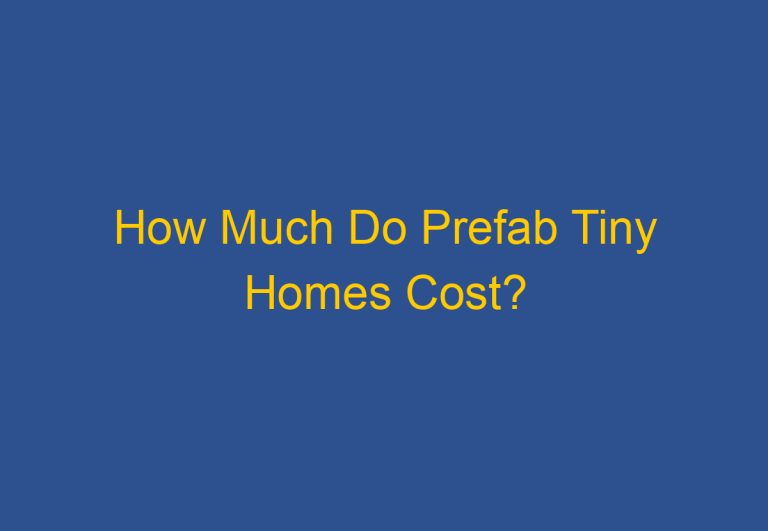How Hard Is It to Build a Tiny House? A Comprehensive Guide
Building a tiny house has become a popular option for those looking to downsize and embrace a minimalist lifestyle. However, many people wonder just how hard it is to build a tiny house. The truth is, building a tiny house can be challenging, but it is also a rewarding experience that allows individuals to create a home that is truly their own.
One of the biggest challenges of building a tiny house is the limited space available. Every square inch of the tiny house must be carefully planned and utilized in order to maximize its functionality. Additionally, building codes and regulations can vary depending on the location, which can add another layer of complexity to the process. However, with careful planning and attention to detail, building a tiny house can be a manageable and enjoyable experience.
For those interested in tiny house living, building a tiny house can be a great way to create a home that fits their unique needs and lifestyle. Whether you are looking to downsize, embrace a minimalist lifestyle, or simply want a home that is more affordable and sustainable, building a tiny house is a viable option. While it can be challenging, the end result is a beautiful and functional home that is truly one-of-a-kind.
Planning Your Tiny House
When it comes to building a tiny house, planning is key. It’s important to carefully consider every aspect of your project before you begin. In this section, we’ll cover the most important steps you need to take when planning your tiny house.
Choosing the Right Location
The first step in planning your tiny house is choosing the right location. You’ll need to find a piece of land that is affordable, eco-friendly, and suitable for your needs. Consider factors such as zoning laws, utilities, and access to transportation and amenities. It’s also important to think about the climate and weather conditions in the area where you plan to build.
Designing Your Floor Plan
Once you’ve chosen your location, it’s time to start designing your floor plan. This is where you’ll decide on the layout and features of your tiny house. Consider factors such as the number of rooms, the size of each room, and the placement of windows and doors. It’s important to create a floor plan that maximizes your space while still providing all the amenities you need.
Securing a Building Permit
Before you can start building your tiny house, you’ll need to secure a building permit. This involves submitting plans and specifications to your local building department and obtaining approval. The process can be time-consuming and complex, so it’s important to start early and work with a professional if necessary.
Budgeting and Financing
Finally, it’s important to consider your budget and financing options when planning your tiny house. Building a tiny house can be an affordable alternative to traditional housing, but it still requires a significant investment. Consider factors such as the cost of materials, labor, and permits, as well as financing options such as loans and grants.
By carefully planning your tiny house project and following a checklist, you can ensure that your project is successful and meets all your needs.
Building Your Tiny House
Building a tiny house can be a challenging yet rewarding experience. The process involves several steps, including preparing the trailer and foundation, constructing walls, roof, and insulation, installing plumbing, electrical, and HVAC, and choosing materials and appliances.
Preparing the Trailer and Foundation
The first step in building a tiny house is to prepare the trailer and foundation. The trailer serves as the foundation of the tiny house, and it is important to ensure that it is level and secure. The trailer should also be inspected for any damages or structural issues.
Once the trailer is inspected and leveled, the foundation can be constructed. This typically involves installing a vapor barrier and laying down the subfloor. The subfloor can be made from plywood or OSB, and it should be secured to the trailer with screws or bolts.
Constructing Walls, Roof, and Insulation
After the foundation is in place, the walls and roof can be constructed. This involves framing the walls and roof with wood or lumber, and then installing sheathing, siding, and roofing materials. The walls and roof should also be insulated with materials like rock wool or spray foam to ensure energy efficiency.
Installing Plumbing, Electrical, and HVAC
Once the walls and roof are in place, the plumbing, electrical, and HVAC systems can be installed. This involves running pipes and wires through the walls and roof, and connecting them to the appropriate fixtures and appliances. It is important to follow building codes and safety regulations when installing these systems.
Choosing Materials and Appliances
Choosing the right materials and appliances for a tiny house is crucial for maximizing space and energy efficiency. This involves selecting materials like flooring, windows, and doors that are appropriate for a small space. It also involves choosing appliances like refrigerators, stoves, and solar panels that are energy-efficient and space-saving.
Overall, building a tiny house requires careful planning, attention to detail, and a willingness to learn and adapt. With the right materials, tools, and knowledge, anyone can build their own tiny house and enjoy the benefits of sustainable living.
Frequently Asked Questions
What are the typical costs associated with building a tiny house?
The cost of building a tiny house can vary widely depending on factors such as the size of the house, the materials used, and the location of the build. On average, building a tiny house can cost anywhere from $10,000 to $50,000. However, it is possible to build a tiny house for less than $10,000 if you are resourceful and able to source affordable materials.
Can a novice realistically build a tiny house on their own?
Yes, it is possible for a novice to build a tiny house on their own. However, it is important to note that building a tiny house requires a significant amount of planning, research, and preparation. It is also important to have a basic knowledge of construction and carpentry. Many people choose to attend workshops or classes to learn the necessary skills before embarking on a tiny house build.
What are the key steps involved in constructing a tiny house from scratch?
The key steps involved in constructing a tiny house from scratch include designing the house, sourcing materials, framing the structure, installing utilities, and finishing the interior. Each of these steps requires careful planning and attention to detail. It is important to take your time and ensure that each step is completed correctly before moving on to the next.
How long does it take to build a tiny house from start to finish?
The time it takes to build a tiny house from start to finish can vary widely depending on factors such as the size of the house, the complexity of the design, and the skill level of the builder. On average, it can take anywhere from several months to a year to complete a tiny house build.
What are the legal considerations when building a tiny house in different states?
The legal considerations when building a tiny house can vary widely depending on the state and local regulations. It is important to research the zoning and building codes in your area before beginning a tiny house build. Some states have specific laws that govern the construction and use of tiny houses, while others may require that tiny houses meet the same building codes as traditional homes.
How can one build a tiny house on a very limited budget?
Building a tiny house on a limited budget requires careful planning and resourcefulness. One way to save money is to source affordable materials, such as reclaimed wood or salvaged materials. It is also important to be willing to do much of the work yourself, rather than hiring expensive contractors. Additionally, attending workshops or classes to learn new skills can help you save money in the long run by allowing you to do more of the work yourself.










